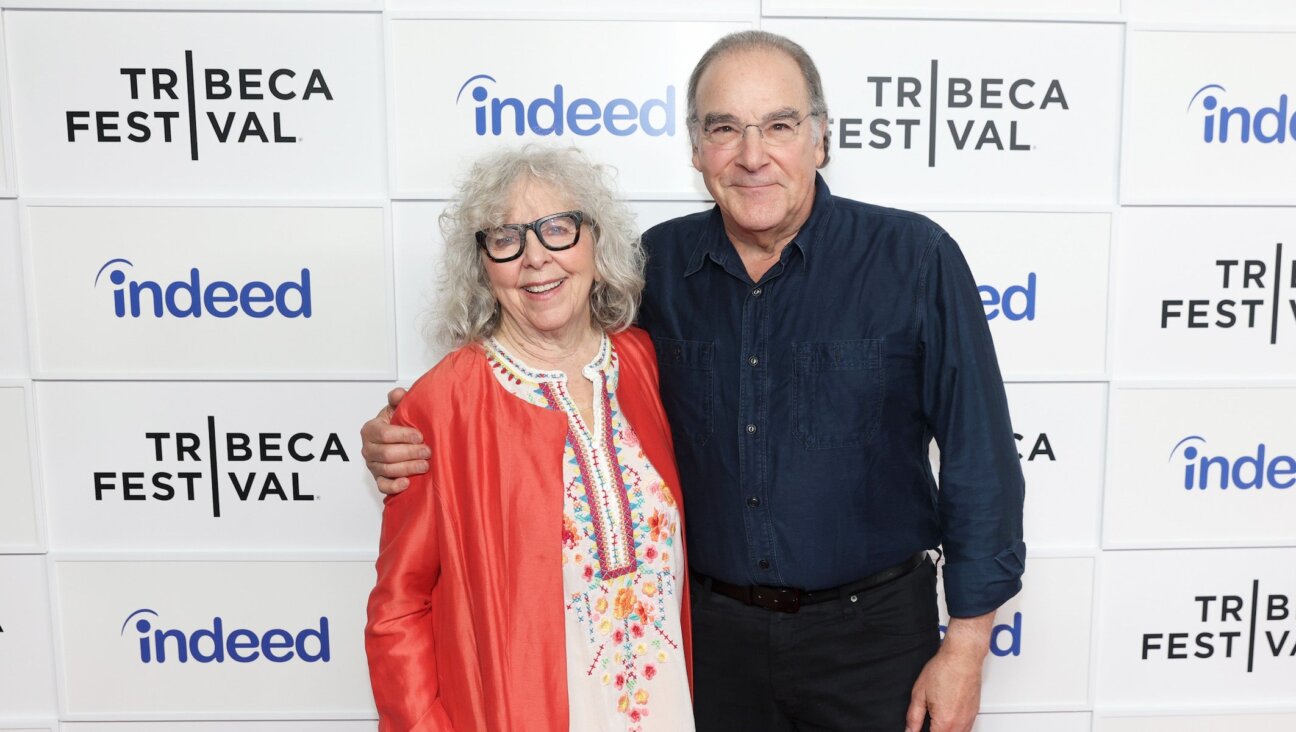Comparing Apples With Apples When It Comes to Executive Pay
Abraham Foxman, national director of the Anti-Defamation League, earned $357,375 last year, not counting benefits. The president of New York’s Mount Sinai Medical Center, Barry Freedman, took in $1.3 million. Are those figures too high?
A report last month in The Chronicle of Philanthropy on the large salaries of Jewish communal executives prompted much clucking and comparisons to the meager wages earned by executives of local community institutions. But a closer examination suggests the comparisons don’t make sense.
Of course, you can’t compare Foxman, who heads an organization with an annual income of $51 million, or Freedman, who leads a major metropolitan hospital with a budget of $2 billion, to the rabbi of a local suburban synagogue. But even within the broader category of national charities, comparing one agency to another is sometimes a case of apples and oranges.
Even experts on the Jewish not-for-profit sector admit they are stumped by the dilemmas. While charity watchdog groups proliferate and attempt to categorize and rank agencies and their executives, Jewish not-for-profits seem to operate in a world of their own. That’s because in the highly specialized world of Jewish fund-raising, their missions and complicated structures vary widely and defy easy categorization, experts say.
“One of the challenges is that everything gets lumped together in the non-profit sector,” said Jeffrey Solomon, president of the Andrea and Charles Bronfman Philanthropies and the former top official of the UJA-Federation of New York. “It’s like trying to compare a local shoemaker to IBM.”
The Chronicle of Philanthropy recently published the top executive salaries of 329 of the largest not-for-profits. Of the groups surveyed, 21 are Jewish communal institutions or, like Mount Sinai Hospital, began as such.
On the list was the Jewish Community Foundation of Los Angeles, a donor-advised fund with an annual budget of $53 million. While the foundation brings in more money than the ADL, its top executive, Marvin Schotland, makes less than two-thirds of what Foxman makes, or $234,055. The Jewish Communal Fund of New York, another donor-advised fund that takes in $160 million — three times the revenue of the ADL — pays its executive vice-president, Susan Dickman, just $180,663, barely half of what Foxman makes.
There may be an element of sexism at work here; Dickman makes far less than Schotland for doing much the same job. But the disparity between the two of them and Foxman is a different story, stemming from the differing natures of the agencies. The ADL is an operating agency that raises charitable donations to pay for the programs it operates. That’s a very different kettle of fish from a community foundation or a donor-advised fund, which provides advice and services to donors who have already decided to give their money away. The nature of the agency goes a long way toward dictating the executive’s compensation.
Even within comparable structures, the income of charity executives is also tied to the size of the organization, according to the Chronicle. While critics often rail against what they call the bloated salaries of Jewish charity executives, especially in times of layoffs and cutbacks, the fact is that the salaries of executives at Jewish charities are usually not too different from those at non-Jewish charities of comparable size and structure. The Chronicle reports that the median income of male execs in all philanthropies that bring in more than $50 million is $319,067. With some exceptions, that roughly accords with the salaries listed for execs at Jewish charities where budgets exceed $50 million.
Some charity watchdogs have developed complex grouping systems to rate similar organizations. But even Jewish groups seldom fall neatly into those frameworks.
The Web-based Charity Navigator (www.charitynavigator.com) sorts 2,500 not-for-profits into nine categories based on their field of endeavor, such as health, religion or public benefit. Navigator then rates the charities by their efficiency, capacity for growth and financial health, using a four-star rating system. Within each category, charities are further divided into fund-raising organizations, community foundations and advocacy or civil rights groups. As the Web site indicates, this kind of classification allows users to compare “apples with apples.”
But it doesn’t always work. The Web site classifies the ADL as an advocacy group, differentiating it from those communal funds. Several charities seem misclassified, however. The American Jewish Congress, a civil rights organization, is grouped with American Friends of Ateret Cohanim, a fund-raising vehicle for a yeshiva in Jerusalem. Thrown in with them is the Hebrew Immigrant Aid Society, the national refugee resettlement agency. The three, though widely different in mandate and fund-raising structure, are grouped together under the heading of “international peace, security and affairs.”
Equally incongruous is the comparison between the religious outreach group Aish Hatorah New York and its international fund-raising body, Jerusalem Fund for Aish Hatorah. They are both classified as religious organizations whose cause is “religious activities,” even though by their own definitions the first operates programs while the second merely raises funds.
With these pitfalls in mind, and with the guidance of experts in the field, the Forward has sketched a rough list of categories within which many Jewish philanthropies fall.
They are:
• Operating agencies: These groups raise and spend most of their own funds, often for advocacy. Examples: the ADL, the American Jewish Committee, the Simon Wiesenthal Center and HIAS.
• American Friends: American charities that raise funds from Diaspora donors to benefit a single institution in Israel. Examples: American Friends of Hebrew University, American Friends of Ateret Cohanim, American Committee for Shaare Zedek Medical Center in Jerusalem and American Committee for the Weizmann Institute of Science.
• Local Jewish charitable federations: These collect thousands of donations of vastly different value and distribute them to many beneficiary agencies. There are 156 across North America.
• Fee-for-service organizations: Like operating agencies, these groups spend the money they raise. But their charitable element is only one part of a much larger revenue structure and they charge for their programs. Fee-for-service charities can be divided into many subgroups including hospitals, museums and universities. Examples: Yeshiva University and Brandeis University.
In a distinct category because they rarely engage in fundraising, foundations provide a tax haven for capital provided by wealthy individuals and use the funds, or their interest, to make grants to charitable causes. They can be broken down into private family foundations — which sometimes operate their own initiatives — and community funds, which often get public funding and support local federations. Among the best-known operational family foundations are the Bronfman Philanthropies and the Wexner Foundation. Two community funds, although not fully comparable, are New York’s donor-advised Jewish Communal Fund and the Jewish Community Foundation of San Diego.
Then, of course, there are organizations that defy easy categorization:
United Jewish Communities, the roof body of Jewish federations, is often misunderstood because it does not raise or spend most of the money it oversees. It functions as a funnel, allocating and overseeing local federation dollars for needs abroad. It is ranked this year as the largest Jewish charity in The Chronicle of Philanthropy’s top 400 list, even though most of its $357,043,000 income consisted of federation allocations passing through en route to overseas agencies. Some of that money, in fact, appears again on the Chronicle’s listing, in the entry for the No. 2 Jewish philanthropic organization, UJA-Federation of New York.
Other anomalies include the American Jewish Joint Distribution Committee, an aid agency that receives much of its income from UJC for social services outside the United States but has been steadily increasing its own fund-raising here; Hadassah, The Women’s Zionist Organization of America, which engages in advocacy here but also funds hospitals and other projects in Israel; The American Jewish World Service, which collects donations here for a panoply of nonsectarian causes abroad such as fighting disease and hunger, but which also operates its own overseas Peace Corps-style programs and runs awareness programs in local American communities.
Proper classifications could help educate donors and thus provide incentive for them to increase their giving, say experts in Jewish philanthropy. But the experts also call for more in-depth analysis of Jewish nonprofits that would assess a charity’s ability to live up to its mission, beyond its finances.
Said Mark Charendoff, president of the Jewish Funders Network, a service agency for family foundations: “If I decide I want to fund Israel advocacy, the fact that one organization is doing it more cheaply than others, or that one is doing it longer than others, doesn’t mean they are the most effective out there.”





















